Sculpture of a detached standing stone located on the extreme edge of Pla des Bruyères, facing the parish church...
I do really enjoy this [presumably first hand account] of Henri Boudet.
"We must not forget the old priest of Rennes, Mr. Boudet, one of those who knows how to make himself loved by all those who arrive, he is a wise archaeologist who described in a very precise volume the numerous Druid monuments of the Rennes valley and has made a study of the most enlightened and most interesting of the Celtic language that he reconstructs with a large number of elements. This is one of the kindest and most interesting men, that one can see, always willing to share his knowledge, it is the visitors who approach him. He has, in his garden, one of the best samples of Gaulish sculpture that was saved from destruction. (The nose had already been destroyed.) It is a bust of a woman, bigger than now, which had been placed again on a pedestal, on a huge stone planted on the steep and narrow ridge to the north, of the town of Rennes, on which she tilts her head and directs her gaze'.
The reference to the 'bust of a woman' in his garden must refer to this;
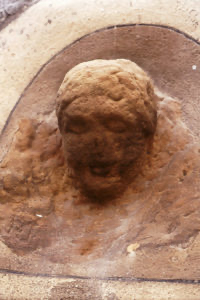
A study published in volume 69 of the SESA talks about this 'head' and gives us the following photos in I,II & III but in IV it is a drawing by Gourdon;
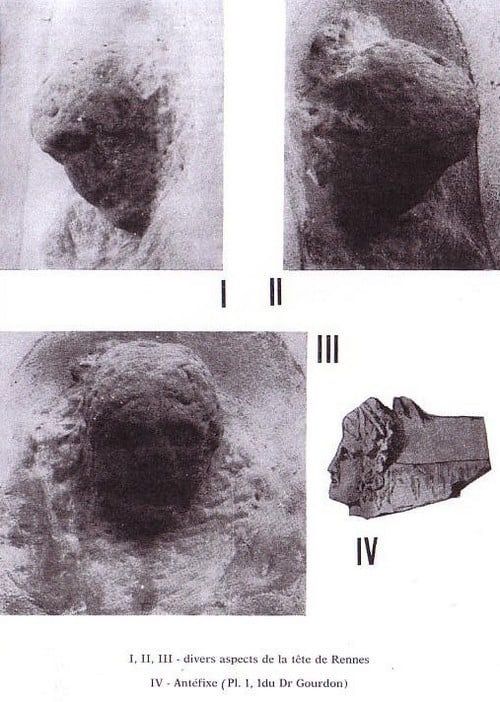
One may ask why the first three are photographs of the head as found in the presbytery of the church at Rennes-les-Bains but the 4th is only a sketch? This is because the sketch is from a work by historian GOURDON, who published his work in 1874 [ie 12 years before Boudet's musings].
Boudet refers to a head 'that he saved from destruction' in his famous book LA VRAI LANGUE CELTIQUE but he described the head of a male, and not just any old 'male';
"the “tête du saviour [is] a menhir [i.e. a standing stone] preserved on this site [a hill above Rennes-les-Bains] and it is a [head] which is carved, in high relief, and represents a magnificent head of the Lord Jesus, the Saviour of Mankind. This sculpture, which has seen approximately 18 centuries, has given its name to this part of the plateau, Cap de l’Homme, the Head of Man, referring to the man par excellence, filius hominis. It is deplorable that we were obliged, in December 1884, to remove this beautiful sculpture from the location it occupied, to remove it from the ravages of a pick-ax of an unfortunate young man, who was far removed from being able to understand the significance and its value".
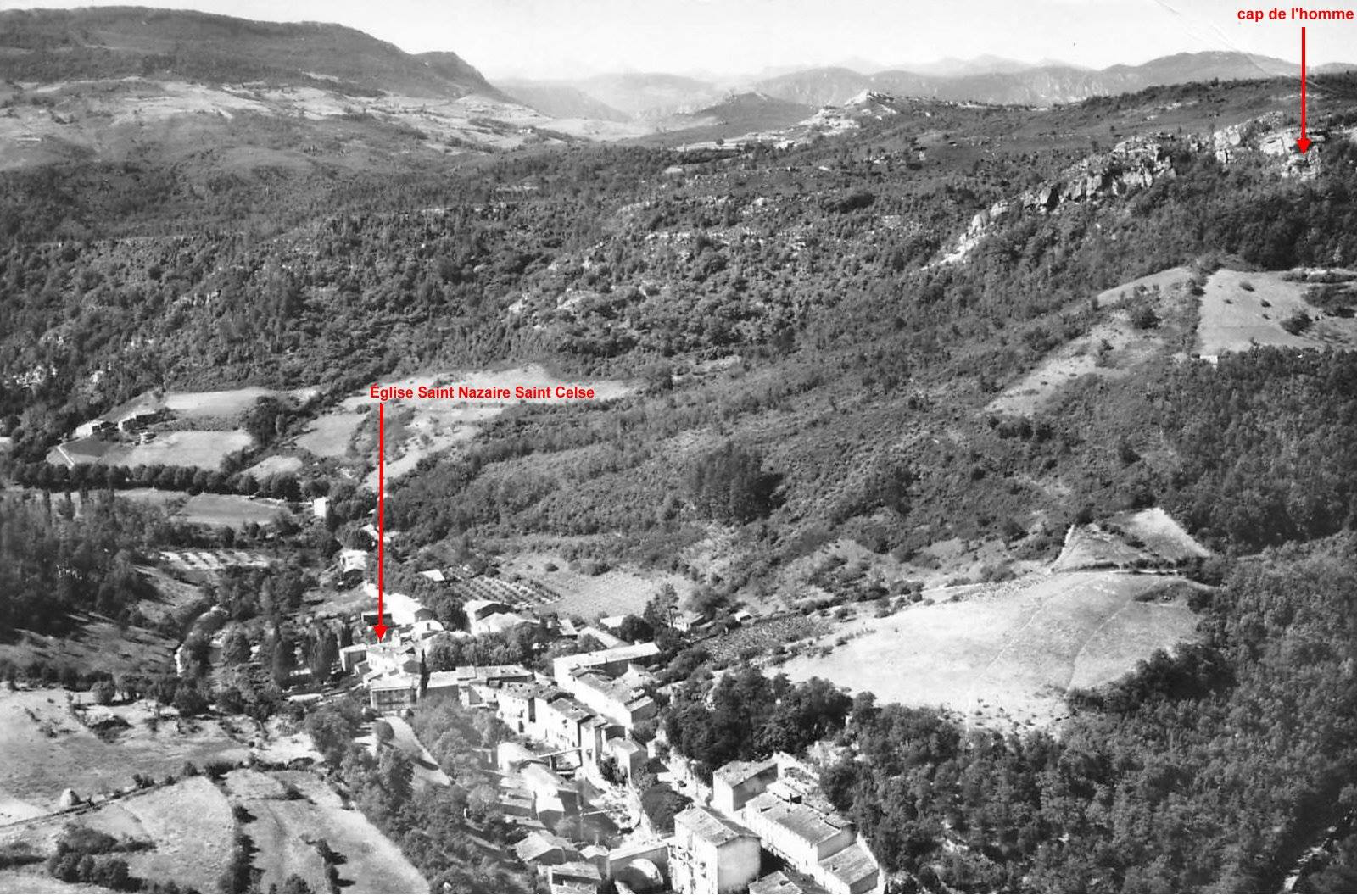
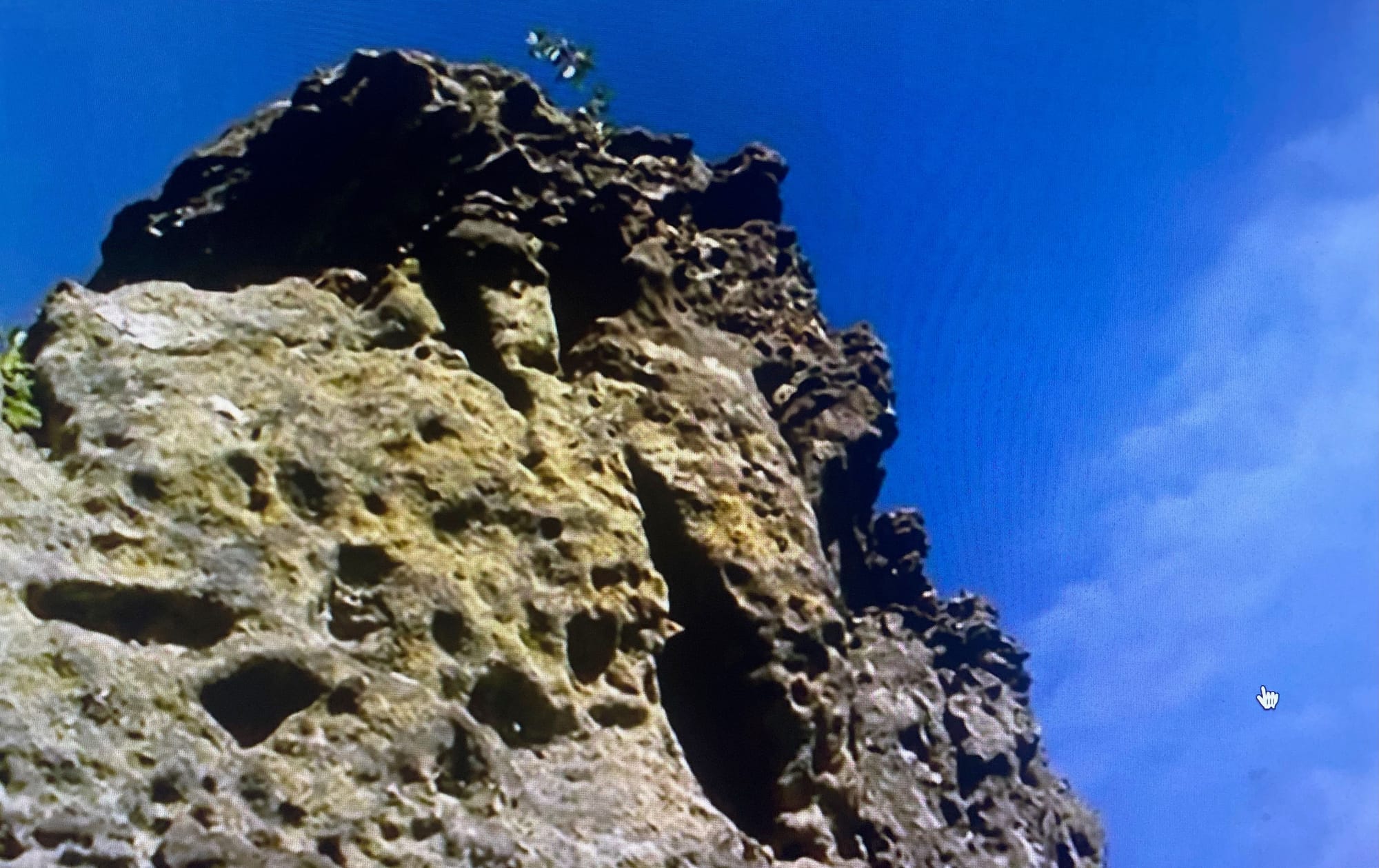
Above - Cap de L'homme
If we put aside for the moment that this quote is from the book 2 years after he had originally 'rescued the head', he states the head is 1800 years old. That is to say the menhir and the sculpture of Jesus Christ overlooking the valley of Rennes dates to AD86! The Cap de L'Homme Menhir is pictured above - who does Boudet think was chiselling the face of Jesus on the face of that mountain, and how did they do it?! It's a sheer cliff face! And in AD86 Christianity was not even a 'thing'. If the Crucifixion took place in Jerusalem around AD33 this statue would have been carved in the Aude 53 years later. With the best will in the world this is patently untrue. If this is what Boudet believed - who did he think knew about this event in the area of Rennes-les-Bains in AD86, and how had the news and it's significance reached the local population?
The area corresponding to the modern-day Aude department in France was part of the Roman province of Gallia Narbonensis. While not yet called "Aude," the region was a vital part of the Roman world, centered around the important city of Narbo Martius (modern Narbonne). The Romans, led by the consul-general Domitius Ahenobarbus, had first occupied the oppidum of Montlaurès in 118 BC, a few kilometres to the north of Narbonne. This became the provincial capital and a very active mercantile port. The position was strategically important since it stood at the crossroads of two Roman roads, the Via Aquitania and the Via Domitia, as well as by the sea near the mouth of the river Aude. Carcassonne became a so-called Latin colony in 30 BC with the creation of numerous grain farms. For almost two centuries, Aude enjoyed peace and strong economic growth.
No Roman citizen could be sent out as a colonist without his free agreement, & Roman citizens willing to go as members of a colony gave their names in at Rome (nomina dederunt, (Liv. I.11). Colonists who settled in these towns became citizens of an independent state. (If they were Roman citizens, they lost citizen rights, but if they decided to return to Rome, they would receive them back again.) The leaders of these new colonies were men who were sent on behalf of a patron, a patron who claimed the colony after its foundation. Suetonius says that "Nero, the father of Tiberius, as a quaestor of Julius Caesar during the Alexandrian war and commander of a fleet, contributed materially to the victory. For this he was made pontiff in place of Publius Scipio and sent to conduct [create] colonies to Gaul, among them Narbo and Arelate. The ancient historians always listed these colonies in specific order. Pliny wrote his list as follows; "...Narbo Martius Decumanorum colonia XII a mari ... distans; ora in autem ̈Athenopolis Massiliensium, Forum Iuli Octavanorum colonia, quae Pacensis appel-â latur and Classica ... In mediterraneo coloniae Arelate Sextanorum, Baeterraeâ Septimanorum, Arausio Secundanorum, in agro Cavarum Valentia, Vienna Allobrogum. Oppida latina Aquae Sextiae Salluviorum, Avennio Cavarum, Apta Julia ̈Vulgentium ... Nemausum Arecomicorum ... Tolosa Tectosagum ...". We must combine this passage to another text, prepared in a different way, from Pomponius Mela, who wrote under the principate of Claudius (41-54) (Choreography, II, 5, 74-76). "Cities that account as the most flourishing are: Vasio in Vocontii , Vienna in Savoyards, in Avennio Cavares among Arecomiques Nemausus, Tolosa of the Tectosages in the colony of II veterans legion: Arausio, the veterans of the sixth: Arelate, that of the seventh: Beaterrae; but one that surpasses them all is the colony Ataciniens and veterans of the Tenth Legion, which once gave their support to country and now is still a glorious name: Narbo Martius. Then the Iuli Forum, a colony of veterans of the eighth legion ... "
Mela establishes a contrast between the colonies of veterans and other provincial cities. The former defines acommunity that highlights the "colonial moment" that began at the end of the Caesarean era and lasted to triumvirale times. That's when the town best met the aspirations of the soldiers of the legions recruited in Italy in a rural and small population. Caesar and Octavian established many colonies of veterans in the provinces. Suetonius, as we saw above said that "Tiberius Nero, the father of Tiberius, was sent to Gaul to create colonies, including those of Narbonne and Arles "(and ad deducendas Galliam in colonias, in quis Narbo and Arelate erant, missus is). Dio Cassius, a historian of the third century indicated for the following period, the account of the events of the years 36 and 35 (LIX, 14, 1-2, and LIX, 34, 4):"... It [was] began by dismissing those who participated with him in the war of Modena against Anthony, then, like the others insisted, he dismissed all of them who had ten years of service ... It was in this way that Caesar then quieted thesoldiers; he gave them the money right away and soon after the land "; Then he adds: "... Some of the dismissed - without gratuity - after the soldiers have consented to resume the service, he formed a legion apart. As they were no more wise for that, he sent a small number of older workers in the colonies of Gaul, thinking to give hope to others and to soothe them". This no doubt this refers to Ceasar keeping his soldiers very happy. And that's what Augustus himself indicated,which was like a balance sheet for his political action - "I have established colonies of soldiers in Africa, Sicily, & Macedonia, in both Hispanies, Achaia, Asia, Syria, Narbonne Gaul and Pisidia " (colonias in Africa Sicilia Macedonia utraque Hispania Achaia Asia Syria Gallia Naarbonensi Pisidia deduxi militum)."
Ceasar added settlers to those already installed in the area, the Atacini. To Caesar, Narbonne was the only colony of Roman citizens: it therefore had a privilege of seniority. As well as remembering the military origins of these towns and villages one wonders why the local historians of Rennes- les-Bains labour the point of an important burial in the area, a burial that would be Roman?
The Tenth legion veterans received land around Narbo Martius. According to Velleius Paterculus (Roman History, 1.15.5), Narbo Martius was founded in 118 BCE as a Roman colonia in land of the Volcae Arecomisci, who lived there on a hill fort that is now named Montlaurès but used to be called Naro (Avienus, 587). The new city was part of the general project to develop this area: the Via Domitia which connected Italy and Hispania. Narbo used to command a crossing in the Arax (Aude), which emptied itself in a lagoon that was connected to the Mediterranean Sea. The Roman town soon became the capital of a new province. Narbo is spoken of as the; "naval-station of the Arecomisci alone, though it would be fairer to add "and of the rest of Celtica" - so greatly has it surpassed the others in the number of people who use it as a trade centre. [...] They are no longer barbarians, but are, for the most part, transformed to the type of the Romans, both in their speech and in their modes of living, and some of them in their civic life as well". [Strabo, Geography, 4.1.12; tr. H.L. Jones]. When Strabo wrote these words, Julius Caesar had already refounded the city. The reason for this was that the most powerful city in southern France, Massilia, had resisted Caesar during the civil wars; the dictator now wanted to break its power and therefore resettled Narbo with veterans of the Tenth legion. The full name of the city was now Colonia Julia Paterna Decumanorum, "the ancestral Julian colony of the soldiers of the Tenth".
Both the Tenth and the Seventh legion are associated with Julius Caesar and a later battle to conquer Marc Anthony. When Caesar became governor of Gallia Cisalpina and Gallia Narbonensis, he took charge of four already existing legions (numbered VII, VIII, IX and X), but during the campaigns in Gaul and in the Civil war against Pompey, the army grew. When Caesar was murdered, there were many more legions, which were taken over by Caesar's successors. In August 48 BCE, Julius Caesar defeated his rival Pompey and the last defenders of the Roman republic in the battle of Pharsalus in Greece. Many died, but Pompey managed to leave the battlefield and tried to obtain asylum in Egypt. However, the Egyptian authorities decided that it was better not to help Pompey, because they suspected that Caesar would declare war upon them. Therefore, Pompey was executed when he tried to come ashore. Not much later, Caesar arrived. The country was divided by civil war: king Ptolemy XII Auletes had left two children who had equal rights to the throne, his son Ptolemy XIII and an elder daughter Cleopatra VII. When Caesar arrived, the boy was in command of the situation. This Cleopatra was later married to Julius Caesar, as her first husband (13 July 100 - 15 March 44 BCE). As we know he was the famous Roman statesman, general and author, famous for the conquest of Gaul (modern France and Belgium) and his subsequent coup d'état. He changed the Roman republic into a monarchy and developed a truly Mediterranean empire. Her second husband was Mark Antony (April 20, 83 BC – August 1, 30 BC), the Roman politician and general. As a military commander and administrator, he was an important supporter and loyal friend of his mother's cousin Julius Caesar. After Caesar's assassination, Antony formed an official political alliance with Octavian (the future Augustus) and Lepidus, known to historians today as the Second Triumvirate.
So if Boudet is/was remotely correct in what he says then it was with these Romans, and specifically, the veteran soldiers who settled the land that would have carried the knowledge of exploits of their regiments in the Middle East. And why not? Boudet, at the end of his book, relates that the Romans built a Temple in Rennes which wa Slater burnt down by Charles Martel! Our erudite priest therefore cited this Saviour's sculpted head in an area that had been settled by veteran Roman soldiers. Pierre Andoque advanced the theory that these Latin colonies were created under the instructions from the father of the Emperor Tiberius himself. This was Tiberius Claudius Nero, often known as Tiberius Nero and Nero (85 BC-33 BC). He was a politician that lived in the last century of the Roman Republic. Nero had served as a quaestor to Julius Caesar in 48 BC, commanding his fleet in the Alexandrian War. Having achieved victory over the Egyptian navy, he was rewarded with a Priesthood. Julius Caesar had sent Nero to create Roman colonies in Gaul and in other provinces [according to Suetonius]. When the Second Triumvirate began to break down, causing a dangerous situation in Rome as the triumvirs went to battle with each other Nero was forced to choose sides and in his distrust of Octavian, he cast his lot with Mark Antony. In 41 BC, he fled Rome with Livia and Tiberius in tow, joining Antony's brother Lucius in Perusia. Perusia was besieged by Octavian's men by the time Nero arrived, and when the town fell in 40 BC, he was forced to flee first to Praeneste, and then Naples. In 40 BC, Octavian and Mark Antony finally reconciled. In Naples, Nero tried in vain to raise a slave battalion against Octavian and then took refuge with Sextus Pompey, who was then acting as a pirate leader in Sicily.
The nearest we can get to any Roman associations with Jesus as per the suggestions by Boudet is that perhaps remnants of the Jewish rebel fighters from the party of Jesus were fleeing from Emperor Tiberius! Or knowledge from the Roman armies associated with rulers in Jerusalem? For example Herod Antipas' fall from power was due to Caligula and to his own nephew Agrippa, brother of Herodias. When Agrippa fell into debt during the reign of Tiberius despite his connections with the imperial family, Herodias persuaded Antipas to provide for him, but the two men quarrelled, and Agrippa departed. After Agrippa was heard expressing to his friend Caligula his eagerness for Tiberius to die and leave room for Caligula to succeed him, he was imprisoned. When Caligula became emperor in 37, he released his friend and granted him rule of Philip's former tetrarchy (slightly extended), with the title of king. Josephus relates that Herodias, jealous at Agrippa's success, persuaded Antipas to ask Caligula for the title of king for himself. However, Agrippa simultaneously presented the emperor with a list of charges against the tetrarch: allegedly, he had conspired against Tiberius with Sejanus (executed in 31) and was plotting against Caligula with King Artabanus. As evidence, Agrippa noted that Antipas had a stockpile of weapons sufficient for 70,000 men. Hearing Antipas' admission to this last charge, Caligula decided to believe the allegations of conspiracy. In the summer of 39, Antipas' money and territory were turned over to Agrippa, while Antipas was exiled. His place of exile is described by Josephus in Antiquities as Lugdunum, a city in Gaul, and as Hispania in The Wars of the Jews. There are two places in France that claim to be the place of exile: Lyon (Lugdunum) and Saint-Bertrand-de-Comminges (Lugdunum Convenae), on the Spanish border. Antipas died in exile. We also know another early Jewish exile to the area was Herod Archelaus.
Perhaps Boudet means to intimate that Jewish refugees from escaping the Emperor came to a colony created by this family, a significant colony at that, almost equal to Rome. But that would make no sense would it? But then, alot of what Boudet wrote did not make sense and one is probably to infer something from it all! Otherwise why would Boudet describe a Head of THE Saviour [we cannot be in doubt to which Saviour he means] being carved 'in high relief' in AD86 above Rennes-les-Bains, which also was opposite the pagan temple, converted into a Christian church later destroyed by fire, was carved a beautiful head of the Saviour looking over the valley, over all the dominant Celtic monuments which had lost their teachings. The victorious cross against paganism, has not ceased to reign in the Cromleck of Rennes-les-Bains, and still maintains, engraved in the religious heart of its inhabitants, the commandments of life given to the world by the Eternal Truth'.
In the Chapter called: LES ROMAINS ET LA SOURCE THERMALE DE LA REINE Boudet writes; the true religious meaning of the Cromleck disappears under all the memories. The southern countries of the Redones had long been part of the Province, and the Romans had built a temple in the valley of the Sals, and baths at the source de la Reine. A new village was built on the plateau of Villanova, overlooking the spa's north-east side. The Romans left many traces of their extended stay in the Cromleck, medals and coins of gold, silver and bronze, from the triumvirate of Antony, Octavian and Lepidus, until the reign of the Emperor Gratian, whole amphorae, broken statues carved in white marble, capitals and bases of columns and carved inscriptions in stone"
What Boudet says actually matches what has happened on the ground in some places at Rennes i.e. evidence of Roman occupation and a substantial one at that around the Source de la Reine, the valley of the Sals and under the Hotel de la Reine and its courtyard and immediate vicinity etc - which includes the speculation by early archaeologists that the remains might suggest ancient Roman buildings, temples and palaces. They equal suggestions that in the valley of the Sals the Romans built a Temple, where archaeologists found, a little below the baths of Rennes, on the right bank of the Sals, the ruins of an old house with mosaic pavements, shards of old pottery and tile's. In the slope opposite the Hotel des Bains de la Reine, there have been found shards of pottery and various forms of crockery, glass perfume bottles, fragments of plaster of apartments, bones of edible animals, oyster shells and other shells. It is in this place that Louis PECH of Narbonne in 1844 guessed the location of a Roman house (left bank of Sals, at the upper entrance to the park), in the ruins of [another?] house, crushed by a boulder, where further bricks were found along with broken glass, animal bones, oyster shells of the Mediterranean, ancient manufacturing nails and a piece of thick greenish glass, similar to those that have been removed from excavations at Pompei. There was speculation that a Temple had been built here [just as Boudet wrote] with some archaeologists such as Mr. ROUZAUD, former president of the Archaeological Survey of Narbonne, attributing the large structures beneath the Hotel de la Reine and a house nearby called Chaluleau to ancient Roman buildings, temples and palaces. In fact on a French forum i found the following quote: "It should also be remembered that in the eighteenth century there was given the name "Valley of the Cross" (Val Crux) to the site of Rennes les Bains, and we [then] understand the special interest that the abbe had in the sign of [the] cross and to the gallows which became 'a' cross - and the locality of Fangallots - whose grounds conceal a Roman necropolis and statues of pagan deities which were exhumed and buried again ..... in the presence of Boudet, in the Chaluleau house at Rennes les Bains". (see HERE)
So at this time the whole are was under the control of rich Romans, retired veterans of the 10th and 7th legions - given land by Emperors as reward for their service. Their stories would have played a large role in the construction of these memories for towns in Gaul. Their relations with Rome, their age, the salient episodes of a common history would all help to build an argument and justify the recognition of a primacy or priority in these endless competitions. The establishment of settlements of veterans in southern Gaul was a highlight of provincial history, at the time of Caesar and at the time of the triumvirate. Well defined in official sources - it was a lasting reference in the memory of those communities, to remind them of their military origin. The intimate relationship between history and memory clearly appears in their world, the communities used coinage to illustrate their origins, particularly through the use of images recalling their foundation myths & legends attached to them, thus combining gods, heroes and men.
And Christianity had not even reached Roman Gaul by AD84!
So much for the male head. The female head? We do not know what became of it but there are illustrations of it given by Gourdon [as referred to above].
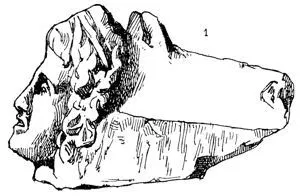
The historian refers to this sculpted head found in an old Roman building - he gives the diagram - and he says the head was found along with much other archaeology. He writes:
.... in several points of the village today, mainly in the part between Bain-Fort and the hamlet of Le Cercle, it has been recognised, at various depths, a great quantity of remains of Roman buildings: constructions of buildings, fragments of mosaics, etc, which may have been part, either of private houses/villas or monuments of another order. The literal space occupied by these objects indicates an extended and fairly large city, in the Valley, spread out to the broader and more Southern area of the village.In this Valley, there was seen, in the middle of a cultivated field, the site of a square house, recognisable from the lines and 'crop marks' found in the vegetation where it was much less bushy than in the corresponding parts of older buildings. It is at this point especially there have been found, in the ground raised by agricultural implements, a huge amount of debris of all kinds, most covered with a layer of ash and charred fragments, testifying to the destiny of this ancient city, which, at the time when the whole country was ravaged by barbarians, was destroyed by fire. ....Among the items discovered in the above cited circumstances, are objects of architecture, sculpture, pottery and various interior utensils, etc.
The objects of architecture seem to be the most significant - they were found on the site of a house that actually forms the last house of the village of Bains, to the South; they consist of several sizable fragments of capitals, columns, etc., of remarkable work, in which it is easy to recognise the debris of a temple, dedicated either to Aesculapius or Hygeia. One of these fragments is the base of a column that can be currently seen at the fountain of the Cercle, where it has been used as a capital/cornice, and that its dimensions allow us to consider that it formed the base of a column of more than 10 meters in height. Also an antefix [?] in white terracotta, of an an elegant model" [my emphasis].
Further research confirms that local eyewitness accounts of early archaeologists during the building of a house associated with Boudet in the area described by Gourdon talked of foundations of a Roman temple where this head was found.
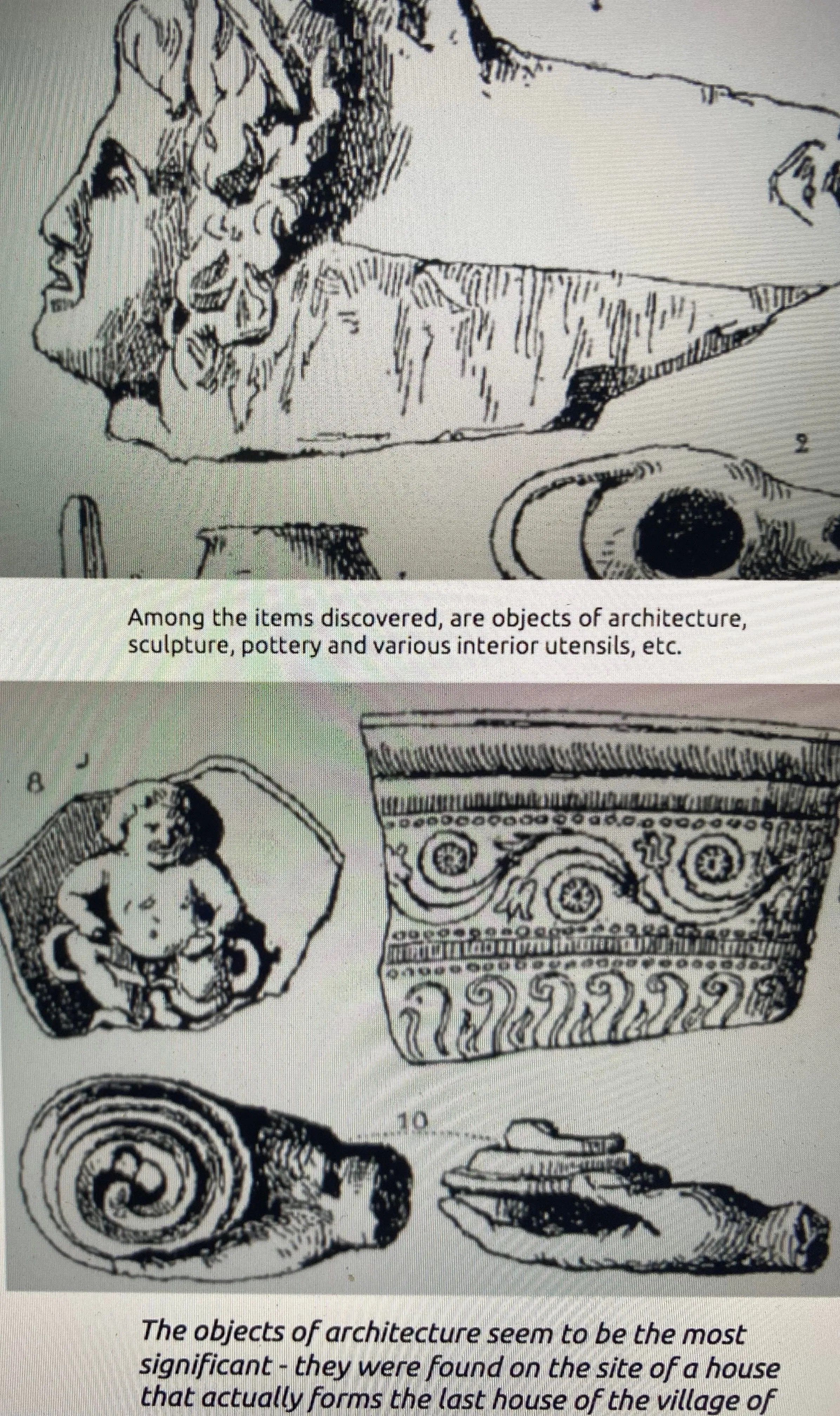
Above - This ante fix is shown for us in diagram and is a female head. Alongside is other objects drawn by Gourdon illustrating finds in the vicinity of Maison Chalaleu!
[An antéfixe is an architectural term describing an ornament of sculpture which was used in antiquity, which decorated the bottom and sometimes the top of the roofs of buildings whether public or private].
From my reading this means the 'Gourdon' head was found among the other archaeology in the valley around the hamlet of Le Cercle, perhaps along with the archaeology that was found on the site of a house that actually forms the last house of the village of Bains, to the South! This house has strong links with Henri Boudet.
Gourdon's head has been described as a female [local Goddess?] which was possibly an ornament that adorned a large public building in the south of the village between Bain Fort and Le Cercle. Gourdon never says his head was sealed in the presbytery at Rennes, and he never says the head was found in the region of Pla de la Côte or Pla des Bruyères. However, on the wall of the presbytery at Rennes-les-Bains, under the carved head placed there - it reads "sculpture of a detached standing stone located on the extreme edge of Pla des Bruyères, facing the parish church [sculpture détachée d'un menhir placé sur l'extrême rebord du Pla des Bruyères, faisant face à l'église paroissiale".] Gourdon goes on:These various objects are kept in the cabinet of M. de Fleury, owner of the Bains and the discoveries - which date back various eras, are only a very small part of what has been found in the country during the course of the last few centuries. It would have been interesting to keep them as souvenirs and as historical evidence of the village's ancient splendour as a spa town, but they have unfortunately disappeared, and is extant only in the writings that we have made mention of.
He refers to the work of Abbe Delmas - who by the way, never cites this 'head' in the presbytery. Therefore it seems this particular head was found after 1709, but before 1874 [when Gourdon mentioned his head] which throws in to question the alleged Boudet find of 1884. Also, of particular note, the Maison Chalaleu - the house associated with the Boudet family - was being built around 1860 so it seems Gourdon was in fact talking of archaeological items found probably when foundations etc were being dug for the creation of dwellings around his time.
Gourdon does describe his head as from a detached 'standing stone' [détachée d'un menhir] which correlates with Boudet's description but it is more likely it was attached to something or a pillar or altar in this old Roman temple found on the site of a house that actually forms the last house of the village of Bains, to the South.